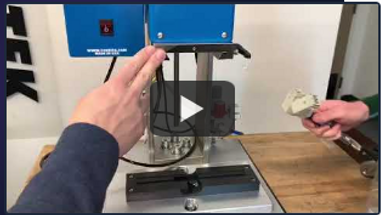1st May 2023
VIDEO: How to use Sonitek Quick Change Tooling
How to Use Sonitek Quick Change Tooling: Step-by-Step Guide
Quick change tooling systems, like the one offered by Sonitek, are essential in improving productivity and efficiency in manufacturing processes. The quick change system allows operators to quickly and safely swap out tooling with minimal downtime. In this blog post, we will cover a step-by-step process on how to use Sonitek Quick Change Tooling.
Prerequisites
Before we dive into the actual process, make sure to take note of the following prerequisites:
-
Ensure that the machine you're working on is powered off.
-
Make certain the tooling is cool before handling it, as it can be hot after use.
-
Connect the machine to an air supply.
Now that we have the prerequisites covered, let's move on to the step-by-step guide for using Sonitek Quick Change Tooling.
Removing the Current Tooling
To remove the current tooling from your machine, follow these steps:
-
Switch the air supply from exhaust to supply to raise the head to the up position, allowing easy access to the tooling.
-
Disconnect the post-cooling (if applicable) from the post-cooling manifold on the upper tooling. This can usually be done by loosening a locking collar or disconnecting quick-disconnect fittings.
-
Disconnect the heaters from the power supply box. This can usually be done by disconnecting electrical connectors or terminal connections.
-
Disengage the tooling clamp on the Quick Change dovetail. This typically involves releasing a locking mechanism or loosening a manually-turned clamp.
-
Slide out the tooling from the machine and place it to the side. Be careful when pulling the heaters and do not rest the upper tooling on the tip faces to prevent accidental damage.
Now that the current tooling has been removed, we can move on to installing a new set.
Installing a New Set of Quick Change Tooling
To install a new set of Quick Change Tooling, follow these steps:
-
Ensure the machine is connected to a clean, dry air source.
-
Set the air supply from exhaust to supply, bringing the actuator to the head-up position.
-
Slide the male dovetail of the new tooling into the female dovetail of the machine, feeding the heaters through the column. Ensure that the mating surfaces of the dovetail are clean and free of debris.
-
Secure the tooling clamp on the female Quick Change dovetail. This typically involves engaging a locking mechanism or tightening a manually-turned clamp.
-
Reattach the heaters to the proper outputs on the back of the power supply. Check your setup sheet for the proper zone and output mapping. Note that the heaters should be labeled with the correct output locations.
-
Reattach the post-cooling airline to the post-cooling manifold. This can usually be done by connecting a quick-disconnect fitting or tightening a locking collar.
-
Check that the alignment stop is in place, ensuring the tooling is properly aligned with the lower tooling.
Once the new set of Quick Change Tooling is installed, your machine is ready to power back on and begin production.
Conclusion
Quick change tooling systems, like the ones offered by Sonitek, provide a significant advantage in manufacturing by reducing downtime and increasing efficiency. By following the step-by-step guide outlined in this blog post, you can ensure that you are safely and effectively utilizing your Sonitek Quick Change Tooling system.

